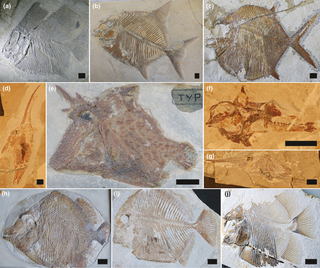
Jean Louis Rodolphe Agassiz FRS (For) FRSE was a Swiss-born American biologist and geologist who is recognized as a scholar of Earth's natural history.

The Lamniformes are an order of sharks commonly known as mackerel sharks. It includes some of the most familiar species of sharks, such as the great white, as well as more unusual representatives, such as the goblin shark and megamouth shark.

Carcharodon is a genus of sharks within the family Lamnidae, colloquially called the "white sharks." The only extant member is the great white shark. The extant species was preceded by a number of fossil (extinct) species including C. hubbelli and C. hastalis. The first appearance of the genus may have been as early as the Early Miocene or Late Oligocene.

The Lamnidae are the family of mackerel sharks known as white sharks. They are large, fast-swimming predatory fish found in oceans worldwide, though prefer environments with colder water. The name of the family is formed from the Greek word lamna, which means "fish of prey", and was derived from the Greek legendary creature, the Lamia.
Acipenser is a genus of sturgeons. With 17 living species, it is the largest genus in the order Acipenseriformes. The genus is paraphyletic, containing all sturgeons that do not belong to Huso, Scaphirhynchus, or Pseudoscaphirhynchus, with many species more closely related to the other three genera than they are to other species of Acipenser. They are native to freshwater and estuarine systems of Eurasia and North America, and most species are threatened. Several species also known to enter near-shore marine environments in the Atlantic, Arctic and Pacific oceans.

Palaeoniscum is an extinct genus of ray-finned fish from the Permian period (Guadalupian-Lopingian) of England, Germany, Turkey, North America and Greenland, and possibly other regions. The genus was named Palaeoniscum in 1818 by Henri Marie Ducrotay de Blainville, but was later misspelled as Palaeoniscus by Blainville and other authors. Palaeoniscum belongs to the family Palaeoniscidae.

Cidaris is a genus of pencil sea urchins.

The Palaeonisciformes, commonly known as "palaeoniscoids" are an extinct grouping of primitive ray-finned fish (Actinopterygii), spanning from the Silurian/Devonian to the Cretaceous. They are generally considered paraphyletic, but their exact relationships to living ray-finned fish are uncertain. While some and perhaps most palaeoniscoids likely belong to the stem-group of Actinopteryii, it has been suggested that some may belong to the crown group, with some of these possibly related to Cladistia and/or Chondrostei. Many palaeoniscoids share a conservative body shape and a similar arrangement of skull bones.

Pycnodontiformes is an extinct order of primarily marine bony fish. The group first appeared during the Late Triassic and disappeared during the Eocene. The group has been found in rock formations in Africa, Asia, Europe, North and South America. They were small to middle-sized fish, generally with laterally-compressed deep bodies, some with almost circular outlines, adapted for manuverability in reef-like environments, though the group was morphologically diverse. Most, but not all members of the groups had jaws with round and flattened teeth, well adapted to crush food items (durophagy), such as echinoderms, crustaceans and molluscs. Some pyncodontiformes developed piranha like teeth used for eating flesh. Most species inhabited shallow marine reef environments, while a handful of species lived in freshwater or brackish conditions. While rare during the Triassic and Early-Middle Jurassic, Pycnodontiformes became abundant and diverse during the Late Jurassic, exhibiting a high but relatively static diversity during the Early Cretaceous. At the beginning of the Late Cretaceous they reached their apex of morphological and species diversity, after which they began to gradually decline, with a more sudden decline at the end of the Cretaceous due to the collapse of reef ecosystems, finally becoming extinct during the Eocene. They are considered to belong to the Neopterygii, but their relationship to other members of that group is uncertain.
Ctenodus is an extinct genus of prehistoric lungfish and the longest-surviving genus of Carboniferous lungfish.
Cassiduloida is an order of sea urchins. The group was extremely diverse with many families and species during the Mesozoic, but today, only seven extant species remain.

Palaeoniscidae is an extinct family of "palaeoniscoid" ray-finned fishes (Actinopterygii).. The family includes the genus Palaeoniscum and potentially other Palaeozoic and Mesozoic early actinopterygian genera. The name is derived from the Ancient Greek words παλαιός and ὀνίσκος.

Spatangus is a genus of heart urchins in the Spatangidae family. The genus is synonymous with the previously recognised genera Prospatangus Lambert, 1902 and Spatagus. There are nine recognised species. The type species is Spatangus purpureus Müller, 1776 by subsequent designation.

Clypeaster, common name "cake urchins" or "sea biscuits", is a genus of echinoderms belonging to the family Clypeasteridae.

Pourtalesia is a genus of the family Pourtalesiidae which belongs to the irregular sea urchins. The animals measure 5–6 cm in length and live in the abyssal zone of the Atlantic, Pacific, Indopacific and Antarctic Oceans where they have been found in more than 3,000 m depth. The mouth opening of these animals is located anteriorly and the lantern of Aristotle is missing as typically for holasteroid sea urchins.

The pourtalesiids (Pourtalesiidae) are a family of irregular sea urchins that live in the deep sea. They are secondarily bilateral-symmetrical and like other representatives of the taxon Holasteroida they lack the lantern of Aristotle, which is typical for many other sea urchins. The genus Pourtalesia was named after Louis-François de Pourtalès who first collected these animals while dredging at a depth of 600 m. The family is known already from the Upper Cretaceous (Maastrichtian) and is distributed worldwide.

Caenopedina is a genus of sea urchins of the family Pedinidae.
Brissopsis is a genus of echinoderms belonging to the family Brissidae.
Brisaster is a genus of echinoderms belonging to the family Schizasteridae.

Strophodus is an extinct genus of durophagous hybodont known from the Triassic to Cretaceous. It was formerly confused with Asteracanthus.













